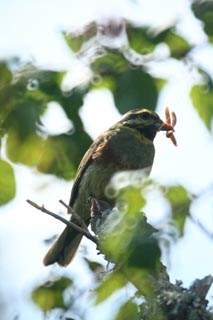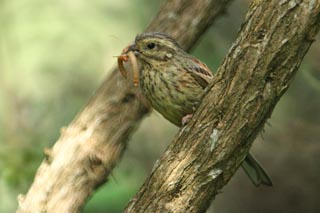 Our last project update heralded the welcome return of the swallows, and I sit here now wondering if this will be the last day I see any this year. Another summer comes and goes, and its time to take stock again of what we’ve achieved in the last six months. It would be easy to succumb to an early bout of Seasonal Affected Disorder with the days drawing in and the cold winds returning, but this year more than ever I have cause for optimism.
Our last project update heralded the welcome return of the swallows, and I sit here now wondering if this will be the last day I see any this year. Another summer comes and goes, and its time to take stock again of what we’ve achieved in the last six months. It would be easy to succumb to an early bout of Seasonal Affected Disorder with the days drawing in and the cold winds returning, but this year more than ever I have cause for optimism.
Our bustling cirl bunting population on the Roseland has increased dramatically, and with it the amount of young born in the area. All the signs in spring pointed towards an increase, but even we could not have hoped for such a sizeable leap forward. Last summer we recorded 16 breeding pairs, but this year we shot up to 28 pairs! This is probably due to a combination of a successful breeding and release campaign last season, and good over-winter survival. And between them these birds have produced at least 69 fledged chicks from nests locally. This figure can be added to another batch of young birds hand-reared and released by the aviculturalists, to create a total much higher than in any previous year. So the population has swelled over the last few months. Although many young birds do not survive their first winter, this had not been a big problem for us in previous years, so we hope that a good proportion of these birds will make it through to breed next year.
 Not only have we seen an increase in the breeding activity, but the birds have been finding new territories and extending their range across the peninsula. We’ve seen a significant movement of birds south towards St Anthony, west across to St Mawes, and north as far as Curgurrell. For sedentary birds this is quite a spread, and has kept the field team on their toes when monitoring new areas. As a result, we’ve also been heavily reliant on Roseland residents to report your sightings, as more and more birds are turning up in areas where we can’t survey them, especially in gardens around the villages. Many of you will not have seen your regular visitors recently as they disperse from the territories to form winter flocks that will feed in fields of over-wintered barley stubbles and bird cover. It’s worth continuing to put down seed in gardens, as some birds may become reliant on it and will return if they know there is a continual source of food. Do keep an eye out as you’re out and about, and please keep any sightings coming in to us.
Not only have we seen an increase in the breeding activity, but the birds have been finding new territories and extending their range across the peninsula. We’ve seen a significant movement of birds south towards St Anthony, west across to St Mawes, and north as far as Curgurrell. For sedentary birds this is quite a spread, and has kept the field team on their toes when monitoring new areas. As a result, we’ve also been heavily reliant on Roseland residents to report your sightings, as more and more birds are turning up in areas where we can’t survey them, especially in gardens around the villages. Many of you will not have seen your regular visitors recently as they disperse from the territories to form winter flocks that will feed in fields of over-wintered barley stubbles and bird cover. It’s worth continuing to put down seed in gardens, as some birds may become reliant on it and will return if they know there is a continual source of food. Do keep an eye out as you’re out and about, and please keep any sightings coming in to us.
 In several cases birds have relocated to areas of farmland where specific management is in place for farmland birds. The local farming community has again made this possible, and its wonderful to see some of them rewarded for their efforts. The work done in partnership with the farmers will continue, to ensure that there is sufficient habitat for the birds to survive here in years to come. This year may be the last year that any birds are translocated from Devon to be hand-reared, but our programme of monitoring will go on. This is partly because the population is still vulnerable at such a low level, but also to assess whether the population will now be able to sustain itself. We may reach the critical threshold next season. Let’s hope that we’ll see another increase like we did this year, and that the population continues to thrive.
In several cases birds have relocated to areas of farmland where specific management is in place for farmland birds. The local farming community has again made this possible, and its wonderful to see some of them rewarded for their efforts. The work done in partnership with the farmers will continue, to ensure that there is sufficient habitat for the birds to survive here in years to come. This year may be the last year that any birds are translocated from Devon to be hand-reared, but our programme of monitoring will go on. This is partly because the population is still vulnerable at such a low level, but also to assess whether the population will now be able to sustain itself. We may reach the critical threshold next season. Let’s hope that we’ll see another increase like we did this year, and that the population continues to thrive.
Nick Tomalin

